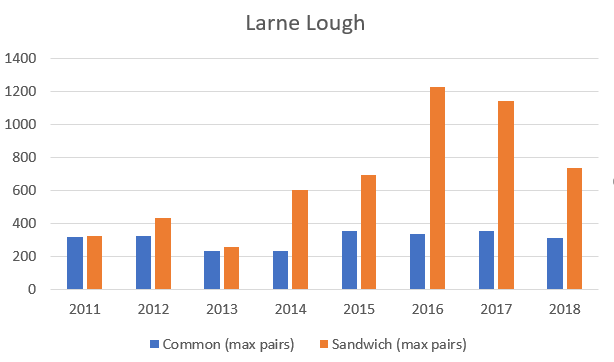|
Larne Lough on Northern Ireland’s east coast provides an important refuge for breeding seabirds owing to a small number of significant factors. The sheltered sea lough provides conditions that are relatively free from the worst of the coastal weather; offshore locations for ground-nesting birds mean that the effects of disturbance and predation are less than at other more vulnerable sites; finally, proximity to productive feeding areas allows breeding adults the best chance to raise chicks to fledging. The site is designated as a Special Protection Area, Area of Special Scientific Interest and a Ramsar site. Swan Island in Larne Lough is a small, low-lying natural island that used to be the sole component of the RSPB Reserve here. However, its tiny (0.14 ha) size and low-lying nature limited the capacity and success of the colony through competition for space and vulnerability to tidal excesses. In the late 1970’s Dinah Browne (RSPB’s erstwhile Regional Director) had the vision to bolster the potential breeding habitat for seabirds on Larne Lough by creating a new island. This new structure would allow for disposal of dredged material arising from the deepening of an access channel to Magheramorne on the shore of Larne Lough, where Blue Circle Industries PLC operated a quarry. An enterprising manager got behind the vision and started work to make Dinah’s vision a reality. The first attempt to create the island in the early 1980’s was not a success due to settling of the original structure. However, in February 1989 Blue Circle Industries PLC restarted work to complete the island. These works involved rebuilding the basalt doughnut, relining the interior with geotextile sheeting, filling the interior with clay and quarry rubble and finally flattening and resurfacing the top layer. In the autumn of 1989 these works were finished but, after a year of settling the north-west corner was identified as needing further attention. This area and the gradually lowering local perimeter of the island remained the primary areas of concern ever since and at high tides water passed through the north-west corner and overtopped the perimeter here, eroding the interior of the island. This c.0.6 ha island was artificially created through depositing quarry spoil from Magheramorne Quarry by Blue Circle Cement (now Tarmac). Construction was completed in 1990 and consisted of placing a ring of basalt blocks on the (shallow) seabed to above the mean high-water mark, before lining with a heavy geotextile, and infilling with two materials that were locally available in large amounts: dredged seabed sediment and inert kiln dust. The restoration of Blue Circle Island came to the fore once again as part of the Roseate Tern LIFE Project. The RSPB identified Blue Circle Island as a priority site for restoration in preparation for a potential expansion of roseate terns from the core strongholds. There are several reasons why this island looks particularly promising for the establishment of a roseate tern colony. Apart from the previously mentioned good food resources and regular breeding attempts, Rockabill (the largest colony in Europe with 1642 pairs in 2018) is only a ‘stone’s throw’ away from Larne Lough in tern travel terms. There is also a stable colony of common terns, which roseates depend on, as well as a large assemblage of Sandwich terns and black-headed gulls, which help provide protection against predators. With the continued management from the RSPB, the restoration of the island was the main issue left to sort out. Almost 50 years after its inception, following 18 months of preparations and two weeks of earthworks , the restoration was completed in the Autumn of 2018. We are now looking forward to the 2019 seabird breeding season. Photo Credits: Daniel Piec
0 Comments
Your comment will be posted after it is approved.
Leave a Reply. |
More Blogs to Read
AuthorThis blog is maintained by various people from the project team. Archives
August 2020
Categories
All
|
Roseate Tern LIFE Project is supported by the LIFE Programme of the European Union
LIFE14 NAT/UK/000394 ROSEATE TERN
LIFE14 NAT/UK/000394 ROSEATE TERN









 RSS Feed
RSS Feed